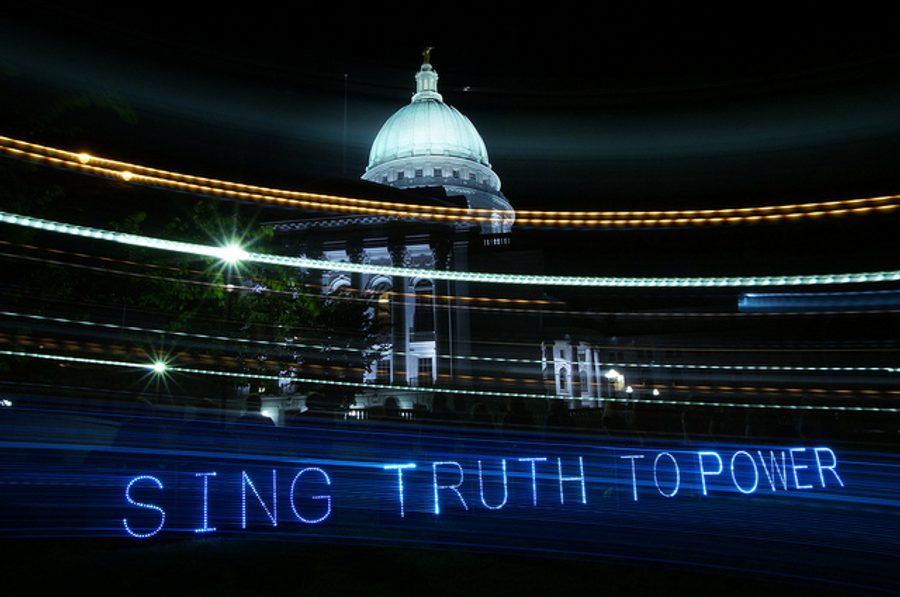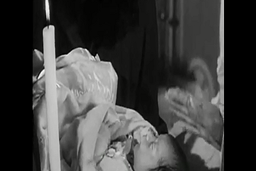The Story Behind ‘Solidarity Forever’
The song “Solidarity Forever” still echoes symbolically in America’s conscience.
Jonathan D. Rosenblum

On a windblown, gray Chicago day in 1915, Ralph Chaplin left his home on the city’s South Side for a raucous poor people’s rally at Hull House, the famed settlement house co-founded by Jane Addams. He asked a visiting friend he’d met organizing coal miners with Mother Jones to listen to the lyrics of a new tune he had been working on:
“Solidarity Forever,
Solidarity Forever,
Solidarity Forever,
For the union makes us strong!”
The self-described Chicago “stiff” and “rebel editor” merely wanted to write a song that could be for workers what “John Brown’s Body” and “Battle Hymn of the Republic” were for abolitionists. In fact, he borrowed the very melody.
Over one hundred years later, despite the rise and precipitous fall of workers’ movements in the U.S., Chaplin’s song is a classic still widely sung with fists raised and demands for justice submitted. It’s an international and national anthem, regularly belted out by “Occupy” and sung every weekday by crowds from 20 to 100 protesters at the Wisconsin State Capitol rotunda.
In place of the slaveholders in “John Brown’s Body” and the “Battle Hymn,” the antagonists of “Solidarity Forever” are railroad barons and rich “parasites,” the takers of “untold millions that they never toiled to earn.”
It is we who plowed the prairies, build the cities where they trade
Dug the mines and build the workshops, endless miles of railway laid
Now we stand outcast and starving ‘mid the wonders we have made…
But the song had a surprising viral ascent to popularity. In Chaplin’s own account in “Why I Wrote Solidarity Forever,” the song initially made its way to struggling workers as the nation’s first “lumberjack” anthem.
Chaplin’s troubadour and journalism work (he also famously designed the Industrial Workers of the World black cat logo) took him around the country. During strikes for safer conditions and the eight-hour day, the tune was introduced to Washington state lumber workers. “Fifty thousand striking Puget Sound loggers bellered it out to a world that didn’t care a hoot about the problems of vote-less and cruelly exploited ‘timber beasts,’ ” Chaplin wrote.
As the IWW’s radical antiwar and pro-wildcat strike tactics got the union increasingly on government enemy lists, Chaplin ended up in Chicago’s Cook County jail and then Leavenworth on a conspiracy rap while his song slowly made its way into the labor canon.
With the workers’ success at winning better terms and the powerful growth of unions, “Solidarity Forever” spread in an arc that would take it across the United States, adopted as the official anthem of the United Auto Workers, and into Canada, France, Latin America and even Australia (one of the early IWW leaders fled there while under suspicion of communist activities; Australian Labor Party leader and former Prime minister Bob Hawke was known to sing it from memory). The French sing it as “Solidarité mes frères et mes soeurs.” A Spanish version can be found in the manual of American community singalongs, “Rise Up Singing.”
Frequently viewed versions online, usually with some modern riffs, range from Leonard Cohen’s antiwar rallying cry from 1970, Pete Seeger’s Almanac Singers, Utah Phillips, and a fabulous new rendition by a kind of rock supergroup in Madison comprised of Tom Morello of Rage Against the Machine, Jackson Brown, Brother Ali, Michael McColgin of The Street Dogs (formerly of Dropkick Murphys) and Tim McIrath of Rise Against. Smithsonian Folkways has just published a story about the Wisconsin rebirth of song circles and new lyrics for Solidarity Forever in its current issue.
What makes the song surprisingly durable, for all its weighty verse, is the controversy that its lyrics and history engendered.
Although the IWW union had few members, its utopian vision of community resembled nothing so much as religious solidarity and a dream of justice. When Chaplin faced trial in 1918 for his newspaper’s views and the union’s alleged antiwar activities, his attorney argued to Chicago’s famous Judge Kenesaw Mountain Landis: “The IWWs say there must be a fundamental change, … the reorganization of industry, for public service, so that the purpose shall be that we will work to live and not merely live to work. Work for service rather than work for profit.” (Chaplin was convicted and served several years in prison until he was released after the war ended.)
In his late-life account of the song, Chaplin described a “life-or-death struggle between fiercely competitive ideological groups to see which of them would shape the future of the then-embryonic left-wing labor movement. It was a knockdown-drag-out fight with no holds barred, and every available weapon from gentle persuasion to brass knuckles was used to gain a fair or unfair advantage.”
Bureaucratic union leaders and concerned political moderates hated the song. When the first AFL-CIO president, conservative George Meany, was getting set to speak at a Washington rally of thousands of political leaders in the 1950s, he called out the singer Joe Glazer ahead of him when he learned the next song would be “Solidarity Forever.” Meany declared, “We can’t have the song of one [big] union.”
But civil rights leaders gave it new life. Even on this Martin Luther King Jr. Holiday weekend, “Solidarity Forever” echoes symbolically in America’s conscience. That’s because Dr. King’s last sermon was delivered in Memphis in anticipation of what historian Michael Honey calls the first-ever strike called not by a union leader, but by a civil rights leader. At the end of his life, King’s agenda included expanding civil rights to the right of all workers to bargain collectively. He was a sworn opponent to right to work legislation that diluted worker voices.
In fact, Dr. King’s last public words mingle with the legacy of “Solidarity Forever.” “Nothing would be more tragic than to stop at this point in Memphis. … You may not be on strike. But either we go up together, or we go down together.” Then he ended with the last words that were from that other “union,” abolitionist song, the one that Ralph Chaplin borrowed the melody and the anti-slavery theme from: “I’m not afraid of any man. Mine eyes have seen the glory of the coming of the Lord!”





